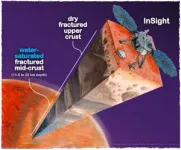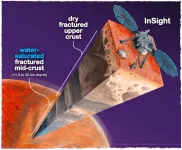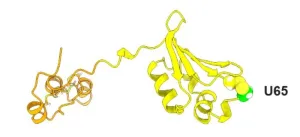(Press-News.org) Respiratory infections can be severe, even deadly, in some individuals, but not in others. Scientists at St. Jude Children’s Research Hospital, the Peter Doherty Institute for Infection and Immunity and other collaborators have gained new understanding of why this is the case by uncovering an early molecular driver that underpins fatal disease. Oleoyl-ACP-hydrolase (OLAH) is an enzyme involved in fatty acid metabolism. A study, published today in Cell, shows that OLAH drives severe disease outcomes.
The important role of OLAH in immune response has gone unrecognized for several reasons, including a lack of noticeable expression in healthy tissue, as well as the difficulty of obtaining datasets reflecting OLAH expression before and after infection. In this study, the researchers pieced together years of collaborative projects spanning multiple diseases to create the comprehensive datasets needed to understand how OLAH works.
“OLAH directly impacts disease severity in multiple globally relevant, but distinct viral infections,” said co-first and co-corresponding author Jeremy Chase Crawford, PhD, St. Jude Department of Host-Microbe Interactions. “We started with the very specific disease context of avian influenza, but by forming these collaborations we were able to interrogate substantially broader disease contexts for this biological mechanism.”
Transcriptomics reveals pivotal role of OLAH
The first clues pointing toward OLAH as a driver of lethal disease came from studies of avian A(H7N9) influenza. Transcriptomic analysis linked expression of OLAH with fatal A(H7N9) infection early after hospital admission, and OLAH levels remained high if a patient’s disease progressed lethally. Patients who recovered from their infection had low OLAH expression throughout their hospital stay. This finding led the researchers to expand their collaborations, looking for expression of OLAH in a variety of different cohorts of people who had experienced infections as well as in mouse models of disease.
“We were generating transcriptomic datasets from several different projects, through years of studying distinct patient cohorts. It occurred to us to look at OLAH, and that’s how we started to see these amazing associations across different diseases,” explained Crawford, who is also a founding member of the St. Jude Center for Infectious Diseases Research.
Through this work, the investigators found high OLAH expression in patients hospitalized with life-threatening seasonal influenza, SARS-CoV-2, respiratory syntactical virus and multi-system inflammatory syndrome in children - but not during mild disease. Additional work with mouse models showed that in mice that were not expressing OLAH, infections that would otherwise be lethal were, in fact, survivable.
Additionally, the researchers found that this effect was accompanied by differential lipid droplet dynamics, reduced viral replication in macrophages and virus-induced inflammation. The work suggests that OLAH-mediated inflammatory responses and severe disease outcomes can be attributed to elevated levels of fatty acids produced by OLAH. This is supported by previous discoveries showing that viral infection in cell lines can be made worse by increased amounts of oleic or palmitic acid. The main product of OLAH is oleic acid.
Potential impact on human health and disease
Co-corresponding and senior author Katherine Kedzierska, PhD, Head of the Human T cell Laboratory at the Doherty Institute, highlighted the research’s significance in advancing our understanding of respiratory viruses and its potential far-reaching impact on patients’ health.
“We’re really excited about the potential of the OLAH gene to serve as a universal indicator of disease severity across different respiratory infections,” said Kedzierska.
“Imagine if your doctor could predict whether your respiratory infection will become life-threatening or if you'll recover rapidly? Our findings suggest that OLAH expression levels could be used as a cutting-edge tool in assessing patients’ prognosis, empowering clinicians with crucial insights for early risk assessment and personalized treatment strategies,” she added.
In addition to defining the role of OLAH in severe respiratory viral disease, the understanding that OLAH expression begins early in severe disease may make it useful as a biomarker to determine if patients need more intense initial treatment. Also, in mouse models, supplementing oleic acid increased influenza replication in macrophages and their inflammatory potential. This may mean that modulating oleic acid levels can be explored as a potential therapeutic approach to disease.
“It took years of working closely with basic scientists and clinicians, from across the world, all studying different infections and diseases, for OLAH’s important role in immune response to come to light. This is just the beginning of our exploration of OLAH; there is a lot more work to be done in infectious disease and other potential applications,” Crawford said.
Authors and funding
The study’s other co-first author is Xiaoxiao Jia, Doherty Institute. The study’s other co-corresponding authors are Zhongfang Wang University of Melbourne and Guangzhou Institute of Respiratory Health, the First Affiliated Hospital of Guangzhou Medical University, and Brendon Chua, Doherty Institute.
The study’s other authors include Deborah Gebregzabher, Hayley McQuilten, Michele Clarke, Annabell Bachem, Isabelle Foo, Svenja Fritzlar, Julio Carrera Montoya, Alice Trenerry, Shuai Nie, Michael Leeming, Thi H O Nguyen, Lukasz Kedzierski, Andrew Kueh, Tina Cardamone, Chinn Yi Wong, Luca Hensen, Aira Cabug, Jennifer Habel, Liyen Loh, Hui-Fern Koay, Carolien E van de Sandt, Linda Wakim, Marco Herold, Igor Konstantinov, Nichollas Scott, Jason Mackenzie, Sammy Bedoui, Patrick Reading, and Sarah Londrigan, University of Melbourne; Ebony Monson, La Trobe University; Yanmin Wan, Shanghai Medical College; Yanqin Ren, Fudan University; Janet Chou, and Tanya Novak, Boston Children’s Hospital; Dene Littler, Monash University; Jamie Gomez Laguna, University of Cordoba; Heather Smallwood, and Mona Agrawal, University of Tennessee Health Science Center; David Boyd, University of California, Santa Cruz; Stuart Berzins, University of Melbourne and Federation University Australia; Katie Flanagan, University of Tasmania; Jamie Rossjohn, Monash University and Cardiff University School of Medicine; Ryan Thwaites, and Christopher Chiu, Imperial College London; Adrienne Randolph, Boston Children’s Hospital and the Center for Influenza Disease and Emergence Response; and Robert Mettelman, Tim Flerlage, Lee-Ann Van de Velde, Amanda Green, and Karla Helbig of St. Jude.
The study was supported by the National Health and Medical Research Council of Australia (#1173871, #1194036, and #2001346), China Scholarship Council-UoM Joint Scholarship, the National Institutes of Health (R01AI136514, U01AI150747), and ALSAC, the fundraising and awareness organization of St. Jude.
St. Jude Children's Research Hospital
St. Jude Children's Research Hospital is leading the way the world understands, treats and cures childhood cancer, sickle cell disease, and other life-threatening disorders. It is the only National Cancer Institute-designated Comprehensive Cancer Center devoted solely to children. Treatments developed at St. Jude have helped push the overall childhood cancer survival rate from 20% to 80% since the hospital opened more than 60 years ago. St. Jude shares the breakthroughs it makes to help doctors and researchers at local hospitals and cancer centers around the world improve the quality of treatment and care for even more children. To learn more, visit stjude.org, read St. Jude Progress, a digital magazine, and follow St. Jude on social media at @stjuderesearch.
END
Study reveals oleoyl-ACP-hydrolase underpins lethal respiratory viral disease
Scientists at St. Jude Children’s Research Hospital, the Peter Doherty Institute for Infection and Immunity, and others reveal high expression of OLAH drives life-threatening immune responses.
2024-08-12
ELSE PRESS RELEASES FROM THIS DATE:
Advances in drug delivery carrier microwave-assisted reactions for enhanced therapeutics and diagnostic purposes
2024-08-12
Microwave irradiation technology is emerging as a powerful tool in the fields of organic synthesis, pharmaceuticals, and nanocarrier development. Recently, microwave-assisted reactions have gained significant attention for their effectiveness in synthesizing drug delivery carriers. This technology offers notable advantages, including high yield, shorter reaction times, and improved compound purity, making it a promising approach for developing nanoparticles with enhanced physicochemical properties and bioavailability.
For more information, please visit: bit.ly/3SFk4cf
For contributing article in this research topic, visit: bit.ly/3WXyoza
Use ...
Presence of liquid water most probable explanation for data collected by mars lander
2024-08-12
Data about Mars’ planetary crust gathered from the Mars InSight lander are best explained by the conclusion that the crust has stores of liquid water.
Analysis led by Vashan Wright, a geophysicist at UC San Diego’s Scripps Institution of Oceanography, provides the best evidence to date that the planet still has liquid water in addition to that frozen at its poles. If that conclusion is true, it sets the stage for new research considering the planet’s habitability and continuing a search for life that exists on a place other than Earth. The potential presence of liquid water on Mars has tantalized scientists for decades. Water is essential for a habitable planet.
“Understanding ...
Scientists find oceans of water on Mars. It's just too deep to tap.
2024-08-12
Using seismic activity to probe the interior of Mars, geophysicists have found evidence for a large underground reservoir of liquid water — enough to fill oceans on the planet's surface.
The data from NASA's Insight lander allowed the scientists to estimate that the amount of groundwater could cover the entire planet to a depth of between 1 and 2 kilometers, or about a mile.
While that’s good news for those tracking the fate of water on the planet after its oceans disappeared more than 3 billion years ago, the reservoir won't be of much use to anyone trying to tap into it to supply a future Mars colony. It's ...
UMass Amherst researchers ID body’s ‘quality control’ regulator for protein folding
2024-08-12
AMHERST, Mass. – Anyone who’s tried to neatly gather a fitted sheet can tell you: folding is hard. Get it wrong with your laundry and the result can be a crumpled, wrinkled mess of fabric, but when folding fails among the approximately 7,000 proteins with an origami-like complexity that regulate essential cellular functions, the result can lead to one of a multitude of serious diseases ranging from emphysema and cystic fibrosis to Alzheimer’s disease. Fortunately, our bodies have a quality-control system ...
Forest restoration can boost people, nature and climate simultaneously
2024-08-12
Forest restoration can benefit humans, boost biodiversity and help tackle climate change simultaneously, new research suggests.
Restoring forests is often seen in terms of “trade-offs” – meaning it often focuses on a specific goal such as capturing carbon, nurturing nature or supporting human livelihoods.
The new study, by the universities of Exeter and Oxford, found that restoration plans aimed at a single goal tend not to deliver the others.
However, “integrated” plans would deliver over 80% of the benefits in all three areas at once.
It also found that ...
Pre-surgical antibody treatment might prevent heart transplant rejection
2024-08-12
A new study from scientists at Cincinnati Children’s suggests there may be a way to further protect transplanted hearts from rejection by preparing the donor organ and the recipient with an anti-inflammatory antibody treatment before surgery occurs.
The findings, published online in PNAS, focus on blocking an innate immune response that normally occurs in response to microbial infections. The same response has been shown to drive dangerous inflammation in transplanted hearts.
In the new study – in mice -- transplanted hearts functioned for longer periods when the organ recipients ...
Scientists identify genes linked to relapse in the most common form of childhood leukemia
2024-08-12
Scientists from St. Jude Children’s Research Hospital, Seattle Children’s and the Children’s Oncology Group (COG) have identified novel genetic variations that influence relapse risk in children with standard risk B-cell acute lymphoblastic leukemia (SR B-ALL), the most common childhood cancer. The identification of genomic predictors of relapse in SR B-ALL provides a basis for improved diagnosis, precise tailoring of treatment intensity and potentially the development of novel treatment approaches. The study was published today in the Journal of ...
Local solvation is decisive for fluorescence of biosensors
2024-08-12
At Ruhr University, the groups of Professor Martina Havenith and Professor Sebastian Kruss collaborated for the study, which took place as part of the Cluster of Excellence “Ruhr Explores Solvation”, RESOLV for short. The PhD students Sanjana Nalige and Phillip Galonska made significant contributions.
Carbon nanotubes as biosensors
Single-walled carbon nanotubes are powerful building blocks for biosensors, as previous studies revealed. Their surface can be chemically tailored with biopolymers or DNA fragments to interact specifically with a certain target molecule. When such molecules bind, the nanotubes change their emission ...
Parents who use humor have better relationships with their children, study finds
2024-08-12
UNIVERSITY PARK, Pa. — They say that laughter is the best medicine, but it could be a good parenting tool too, according to a new study led by researchers from Penn State.
In a pilot study, the research team found that most people viewed humor as an effective parenting tool and that a parent or caregiver’s use of humor affected the quality of their relationship with their children. Among those whose parents used humor, the majority viewed their relationship with their parents and the way they were ...
HHMI invests $500 million in AI-driven life sciences research
2024-08-12
The Howard Hughes Medical Institute today announced AI@HHMI, a $500 million investment over the next 10 years to support artificial intelligence-driven projects in the life sciences. As the largest private biomedical research organization in the United States, HHMI aims to explore the full promise of AI to accelerate scientific discovery at its Janelia Research Campus in Ashburn, Virginia, and at the more than 300 HHMI-affiliated labs.
“By bringing human curiosity and artificial intelligence closer together at every phase of experimentation ...
LAST 30 PRESS RELEASES:
Numbers in our sights affect how we perceive space
SIMJ announces global collaborative book project in commemoration of its 75th anniversary
Air pollution exposure and birth weight
Obstructive sleep apnea risk and mental health conditions among older adults
How talking slows eye movements behind the wheel
The Ceramic Society of Japan’s Oxoate Ceramics Research Association launches new international book project
Heart-brain connection: international study reveals the role of the vagus nerve in keeping the heart young
Researchers identify Rb1 as a predictive biomarker for a new therapeutic strategy in some breast cancers
Survey reveals ethical gaps slowing AI adoption in pediatric surgery
Stimulant ADHD medications work differently than thought
AI overestimates how smart people are, according to HSE economists
HSE researchers create genome-wide map of quadruplexes
Scientists boost cell "powerhouses" to burn more calories
Automatic label checking: The missing step in making reliable medical AI
Low daily alcohol intake linked to 50% heightened mouth cancer risk in India
American Meteorological Society announces Rick Spinrad as 2026 President-Elect
Biomass-based carbon capture spotlighted in newly released global climate webinar recording
Illuminating invisible nano pollutants: advanced bioimaging tracks the full journey of emerging nanoscale contaminants in living systems
How does age affect recovery from spinal cord injury?
Novel AI tool offers prognosis for patients with head and neck cancer
Fathers’ microplastic exposure tied to their children’s metabolic problems
Research validates laboratory model for studying high-grade serous ovarian cancer
SIR 2026 delivers transformative breakthroughs in minimally invasive medicine to improve patient care
Stem Cell Reports most downloaded papers of 2025 highlight the breadth and impact of stem cell research
Oxford-led study estimates NHS spends around 3% of its primary and secondary care budget on the health impacts of heat and cold in England
A researcher’s long quest leads to a smart composite breakthrough
Urban wild bees act as “microbial sensors” of city health.
New study finds where you live affects recovery after a hip fracture
Forecasting the impact of fully automated vehicle adoption on US road traffic injuries
Alcohol-related hospitalizations from 2016 to 2022
[Press-News.org] Study reveals oleoyl-ACP-hydrolase underpins lethal respiratory viral diseaseScientists at St. Jude Children’s Research Hospital, the Peter Doherty Institute for Infection and Immunity, and others reveal high expression of OLAH drives life-threatening immune responses.






